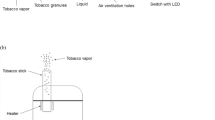Abstract
Approximately 173 subjects employed as waiters, waitresses, or bartenders in the Knoxville, TN, Standard Metropolitan Statistical Area collected a sample of air from their breathing zone while at their workplace for one shift. In addition, area samples were placed near the work spaces of many of the subjects. Collected samples were analyzed for respirable suspended particulate matter (RSPM), ultraviolet-absorbing and fluorescing particulate matter, solanesol, 3-ethenyl pyridine (3-EP), and nicotine. Saliva samples were collected from the subjects prior to and within 24 h following their work shift, to confirm their non-smoking status. The range of concentrations of environmental tobacco smoke (ETS) constituents encountered was considerable, e.g., for nicotine, from undetectable to more than 100 µg/m3. However, the highest RSP levels observed were considerably lower than OSHA workplace standards. Distributions of ETS concentrations suggest that there are two “ETS exposure” types of bartenders: those that work in single room bars and those that work in larger, multi-room restaurant/bars. Personal exposure to ETS of the former group was ca. 10× greater than those of the latter group, who were exposed to ETS levels more comparable to those encountered by wait staff. Exposure (concentration×duration) differences between wait staff and workers in other types of unrestricted smoking environments reported in other studies suggest that exposures in the restaurant environment may be more difficult to assess than originally considered. Salivary cotinine levels indicated that for those subjects living in smoking homes, ETS exposures outside the workplace are at least as important as those in the workplace.
This is a preview of subscription content, access via your institution
Access options
Subscribe to this journal
Receive 6 print issues and online access
$259.00 per year
only $43.17 per issue
Buy this article
- Purchase on Springer Link
- Instant access to full article PDF
Prices may be subject to local taxes which are calculated during checkout
Similar content being viewed by others
Author information
Authors and Affiliations
Corresponding author
Rights and permissions
About this article
Cite this article
MASKARINEC, M., JENKINS, R., COUNTS, R. et al. Determination of exposure to environmental tobacco smoke in restaurant and tavern workers in one US city. J Expo Sci Environ Epidemiol 10, 36–49 (2000). https://doi.org/10.1038/sj.jea.7500069
Received:
Accepted:
Published:
Issue Date:
DOI: https://doi.org/10.1038/sj.jea.7500069
Keywords
This article is cited by
-
Acute cardiovascular autonomic responses to inhaled particulates
European Journal of Applied Physiology (2015)
-
Dynamic behavior modeling of cigarette smoke particles inside the car cabin with different ventilation scenarios
International Journal of Environmental Science & Technology (2011)
-
Quantification of ETS exposure in hospitality workers who have never smoked
Environmental Health (2010)
-
Exposure to environmental tobacco smoke in German restaurants, pubs and discotheques
Journal of Exposure Science & Environmental Epidemiology (2008)
-
An evaluation of the indoor air quality in bars before and after a smoking ban in Austin, Texas
Journal of Exposure Science & Environmental Epidemiology (2007)



